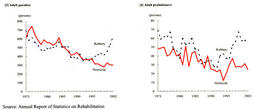| Previous Next Index Image Index Year Selection | |
|
|
2 Probationary supervision (1) Probationary supervision for juveniles and probationary supervision after release on parole from juvenile training school Fig. 5-6-3-3[1] and [2] show the trends in the number of newly received juveniles placed under probation (juvenile probationers) for committing homicide/robbery and juveniles, who committed homicide/robbery, subject to probation after release on parole from juvenile training schools (juvenile parolees).
The number of newly received juvenile probationers is very small for homicide and has been flat or on a downward trend. For robbery, the number has been rapidly increasing since 1993, reaching a 2.3-fold increase from 1993 in 2002. The number of newly received juvenile parolees is small for homicide but shows a slightly upward trend, while the number for robbery has been on an upward trend since 1995, reaching a 2.9-fold increase from 1995 in 2002. This is probably because the number of those committed to juvenile training schools due to robbery has increased. (2) Probationary supervision after release on parole from penal institutions and probationary supervision during the period of the suspension of execution of sentence Fig. 5-6-3-3 [3] and [4] show the trends in the number of newly received offenders who were placed under probation after release on parole from penal institutions (adult parolees) and offenders granted suspended sentence with probationary supervision (adult probationers) with respect to those who committed homicide/robbery. The number of adult parolees for homicide has been on a downward trend while the number for robbery had been on a downward trend until 1994 but has been on an upward trend since then. This is probably because the number of offenders who commit robbery and serve their sentences in prisons has increased. There are only a small number of adult probationers, and the number for homicide has been constantly decreasing while the number for robbery had been on a downward trend but has turned to an upward trend since 1993.
Fig. 5-6-3-3 Trends in the number of newly received parolees and probationers |

